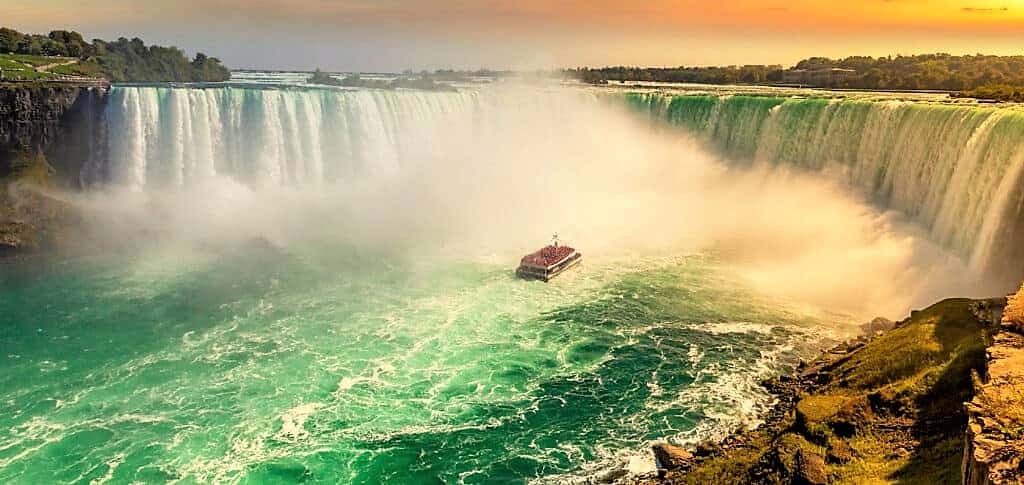Top-5 little known facts about Niagara Falls
Published June 28, 2022 at 10:15 am

Before we get started here, a quick question. Is Niagara Falls one of the Seven Wonders of the World? Many think so but in actual fact, the Seven Wonders of the Ancient World are: Great Pyramid of Giza; Hanging Gardens of Babylon, Statue of Zeus, Colossus of Rhodes; Temple of Artemis; Mausoleum at Halicarnassus and Pharos of Alexandria.
That is why Niagara Falls is often called “The Eighth Wonder of the World.” Now you know. However, it may not have officially cracked the list, there is no small amount of wonder around the falls – Horseshoe Falls in Canada (which represents 90 per cent of the Niagara River flow), the American Falls and the tiny Bridal Veil Falls next to the American one.
So here’s the Top-Five little-known facts about Niagara Falls you might not know.
5) The Niagara River flows ‘backwards’
The Niagara River, which, of course, flows from Lake Erie over the falls and into Lake Ontario, is one of the few waterways in the world that flows from south to north. North to south is the case for the huge majority of rivers in the world. The best-known north-to-south exception would be the Nile River. So how does that happen? The deciding factor in the way it flows is the slope of the land. Starting at Lake Erie, the Niagara River slopes down northbound to Lake Ontario and has an elevation change of 326 feet or 99 metres. Slightly more half of that elevation – 170 feet or 52 metres – change comes in one drop at Niagara Falls.
4) Where does the name Niagara come from?
The “falls” in Niagara Falls is obvious but where did the “Niagara” come from? There’s more than a few theories but the most credible one is that it’s a derivative of the Iroquoian word “Onguiaahra” which is pronounced nee-agg-arah. The name, which appeared on maps as early as 1641, was later anglicized by missionaries. There are several accepted meanings – “the strait – or straight” or the more epic “thundering water.” It refers to both the Niagara River (the straight) and the falls (the thundering).
3) Niagara Falls is the largest falls in North America but a pipsqueak compared to others
Yes, Niagara Falls is the biggest waterfall in North America but there are nearly 500 waterfalls around the world that are higher. However, the three waterfalls of Niagara create the highest flow rate of any waterfall on the planet – 225,000 cubic feet or 6,400 cubic metres per second over just the Horseshoe Falls. That flow could fill an Olympic sized swimming pool in half a second. But over 28 million litres of water per second could fill a lot of pools.
2) A huge amount of the water we see ends up in people’s taps
Niagara Falls provide nearly one-fifth of drinking water in America. But don’t drink it first as it may contain microorganisms or parasites not fit for consumption. Even though 7.4 million gallons of water flows over the falls every second, somewhere between 50 and 75 per cent of the water flowing in the Niagara River is diverted away for human consumption. Less water is diverted in summer to provide a better show for tourists but it’s hard to imagine even more water than there is.
1) A modern-day Noah’s Ark once went over Niagara Falls. It didn’t end well.
It’s been estimated that roughly 90 per cent of the fish that go over the falls survive the plunge due to the oxygenated levels of the water once it breaks the crest of the falls. Granted, fish have little choice once they hit the rapids in Niagara River which flow at 25 mph (40 km/h) and reach 68 mph (110 km/h) by the time they hit the falls.
However, other animals would not fare well. In 1827, a group of hotel owners decided a great promotion would be to send a boat filled with animals over the falls. They found a condemned merchant ship and loaded it up with a buffalo, two small bears, two raccoons, a dog, and a goose. However, a few reports from the day added two fox, 15 geese and one eagle to the cargo list. On September 8 at 6 pm, it went over the falls.
Only one goose survived.
